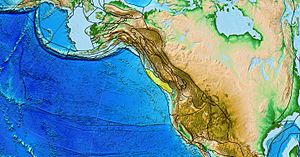Wrangellia Terrane facts for kids
The Wrangellia Terrane is a huge piece of Earth's crust. It stretches from Alaska through Yukon and along the coast of British Columbia in Canada. Think of it like a giant puzzle piece that moved around the Earth! Geologists study terranes to understand how continents formed and moved over millions of years.
Contents
What is Wrangellia?
Wrangellia is a special type of landmass called a terrane. A terrane is a piece of crust that formed somewhere else and then joined a larger continent. The Wrangellia Terrane is named after the Wrangell Mountains in Alaska.
Sometimes, when geologists talk about "Wrangellia," they might mean:
- Just the Wrangellia Terrane itself.
- A bigger group of land pieces that includes Wrangellia, the Peninsular Terrane, and other parts. These pieces were not originally part of North America.
- An even larger group that also includes the Alexander Terrane.
It's a bit like different-sized building blocks that all fit together!
How Wrangellia Formed and Moved
Scientists have two main ideas about where Wrangellia came from and how it moved to its current spot. Both ideas agree that Wrangellia was once far away from where it is now.
Idea 1: It Started Nearby
One idea is that Wrangellia formed in a northern area, close to where it is today. Back then, North America (also called Laurentia) was part of a supercontinent called Pangaea.
Geological clues suggest that as some ancient oceans closed, new oceans opened. This caused pieces of land, like the Alexander Terrane, to drift westward. The Alexander Terrane later joined with Wrangellia. These two land pieces floated in the ocean for a long time. They finally joined North America during the Middle Jurassic period.
Idea 2: It Traveled Far from the Equator
The second idea, which many scientists favor, is that Wrangellia started much farther south. It might have begun about 3,000 km (1,900 mi) south of its current location, perhaps near where Baja California is today.
The rocks of Wrangellia were created between the Pennsylvanian and Jurassic periods. They formed in the Panthalassic Ocean, which was a huge ocean surrounding Pangaea. These rocks came from places like island arcs (chains of volcanoes like Japan) and oceanic plateaus (large, flat areas on the ocean floor).
A key feature of Wrangellia is its huge lava flows. About 230 million years ago, during the Late Triassic period, massive amounts of lava erupted. This lava covered the land over 5 million years. These ancient lava flows are called flood basalts. They form a "large igneous province," which means a huge area covered by volcanic rock. Today, these lava flows stretch for 2,500 km (1,553 mi)!
Wrangellia eventually crashed into and joined with the Alexander Terrane. By the end of the Triassic, the Peninsular Terrane also joined this growing landmass.
On the western side of Wrangellia, there was a subduction zone. This is where one Earth plate slides underneath another. Rocks that were too light to be pulled down were squeezed against Wrangellia. These rocks now form the Chugach Terrane. A complex system of cracks in the Earth, called the Border Ranges Fault, shows where Wrangellia and the Chugach Terrane joined.
Over time, plate tectonics moved this combined landmass generally northeastward. Wrangellia finally collided with and attached to North America by the Cretaceous period. Even after joining, Wrangellia continued to slide northward along large faults.


